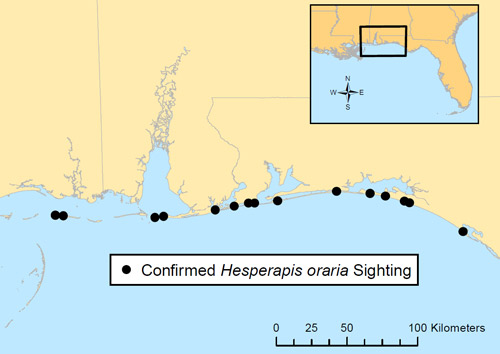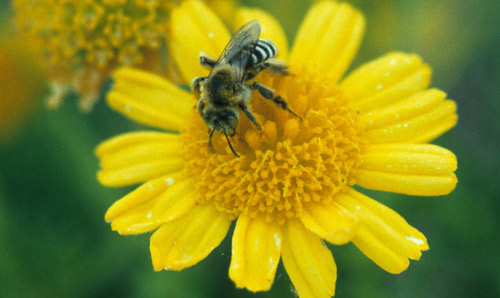common name: coastal plain hesperapis (suggested common name)
scientific name: Hesperapis oraria Snelling and Stage (Insecta: Hymenoptera: Melittidae)
Introduction - Distribution - Description - Biology - Host Plants - Management - Acknowledgements - Selected References
Introduction (Back to Top)
Hesperapis oraria Snelling and Stage is a specialized, solitary bee belonging to the family Melittidae (Dasypodainae). Hesperapis species are found throughout North America and typically forage on multiple plant species. However, Hesperapis oraria is the only species to be identified east of the Mississippi River. Furthermore, Hesperapis oraria is an extreme specialist as it only forages on one Asteraceae species (the coastal plain honeycombhead, Balduina angustifolia) for all of its pollen and nectar needs.
Distribution (Back to Top)
Hesperapis oraria is restricted to a very small geographic region on the sandy barrier islands along the northern margins of the Gulf of Mexico, from Horn Island, Mississippi eastward to Saint Andrew’s Bay, Florida (Fig. 1). Hesperapis oraria’s entire range is estimated to be less than 100 km2.
Figure 1. The known distribution of Hesperapis oraria on the barrier islands along the northern margins of the Gulf of Mexico from Horn Island, Mississippi eastward to Saint Andrew’s Bay, Florida. Figure adapted from Cane et al. (1996) by Chase Kimmel, University of Florida. Map base layer provided by NRCS Geospatial Data Gateway.
Description (Back to Top)
Physical descriptions of the immature life stages (egg, larvae, and pupae) of Hesperapis oraria are not available because these life stages are completed within the nest, and nests have yet to be located.
Adults: Both adult males and females have two pairs of wings. The legs are dark brown with reddish tarsi (last segment of the leg). Their bodies are covered in dense, branched hairs, and their abdomens have distinct black and white bands (Fig. 2). Females range from 11 to 13 mm in length, whereas males range from 8.2 to 11.3 mm in length. Females have modified hairs on their hind legs that are thought to allow them to push dry sand as they excavate sand during nest building.
Figure 2. Adult female Hesperapis oraria foraging on coastal plain honeycombhead (Balduina angustifolia). Photograph by John Bente, Florida Department of Environmental Protection, Florida Park Service.
Biology (Back to Top)
Hesperapis oraria is a member of the subgenus Carinapis. All Carinapis species are associated with sandy soils, such as the soil found in the distribution area of Hesperapis oraria. Furthermore all adult females in this subgenus have the hind leg adaptation described above that is believed to facilitate excavating nests in the sand. Within the subgenus Carinapis Hesperapis oraia is a member of the carinata group. The carinata group consists of six species: Hesperapis oraia, Hesperapis rodecki Cockerell, Hesperapi carinata Stevens, and three additional known but undescribed species.
The nesting habits of most species in the Carinapis subgenus are unknown. Furthermore, only the nesting biology of one of the undescribed species in the carinata group has been studied. Hesperapis oraria nests have not been found. Therefore, much of their life history has been inferred from what is known about their foraging behavior and the nesting behavior of the undescribed carinata species. Here we describe the biology of this closely related species, under the assumption that Hesperapis oraria’s biology may be similar.
Females of the undescribed carinata species build their nests in aggregations that may have as many as 25 nests per m². Within these aggregations, each female builds and provisions her own nest. The nest is built by excavating a central tunnel that has several short side tunnels. The central tunnel is typically between 150-200 cm deep, and a small mound is formed at the nest opening. In each side tunnel, 1-6 unlined cells are constructed. Each cell is provisioned with pollen and nectar and an egg is laid on the pollen/nectar mass.
Within 2 km of the shore inland, female Hesperapis oraria can be observed leaving foraging areas and carrying loads of pollen. However, no nests were found in the coastal plain honeycombhead stands where the females were foraging. Furthermore, Hesperapis oraria is believed to nest within 2 km from the shore because of restriction to the more crumbly sands found in back-dune habitats, and foraging females were not found in coastal plain honeycombhead stands only 3 km inland.
Hesperapis oraria is most likely univoltine, meaning they produce one cohort of brood per year. Adults emerge from late September to mid-October, and mating is expected to occur soon after emergence. The adult female then spends the rest of her life building nests, provisioning cells, and laying eggs that will develop and emerge as adults the following year.
Host Plants (Back to Top)
Hesperapis oraria is monolectic, meaning they only eat pollen and nectar from a single species of plant (the coastal plain honeycombhead; Fig. 3). Coastal plain honeycombhead can be found in Georgia and throughout the Florida peninsula. However, Hesperapis oraria is only found on a specific range of barrier islands. This suggests that more environmental factors than host plant availability, such as nest substrate needs, influence the distribution of Hesperapis oraria.
Figure 3. Adult male Hesperapis oraria foraging on a coastal plain honeycombhead(Balduina angustifolia) flower. Figure by Jim Cane, USDA-ARS Pollinating Insect Research Unit, Utah State University.
Management (Back to Top)
Only the foraging habitat of Hesperapis oraria has been documented. Before a comprehensive conservation plan can be designed and implemented, nest locations and nesting behavior must also be documented. However, the narrow range and specificity of their coastal dune habitat makes Hesperapis oraria a potential candidate for conservation efforts.
Coastal real estate development continues to reduce available foraging and nesting habitat. Encouraging landowners and to grow coastal plain honeycombhead potentially could compensate for the loss of habitat. Furthermore, the back dune habitats where Hesperapis oraria is found are subject to aerial insecticidal sprays to control pests such as biting flies. The reduction or elimination of aerial spraying is also recommended in regions that host Hesperapis oraria.
Acknowledgements (Back to Top)
Reviews provided by Cory Stanley-Star and Glenn Hall, Entomology and Nematology Department, University of Florida; Jim Cane, USDA-ARS Pollinating Insect Research Unit, Utah State University.
Selected References (Back to Top)
- Cane J. 1991. Soils of ground-nesting bees (Hymenoptera: Apoidea): Texture, moisture, cell depth and climate. Journal of the Kansas Entomological Society 64: 406-413.
- Cane J. 1997. Violent weather and bees: Populations of the Barrier Island endemic, Hesperapis oraria (Hymenoptera: Melittidae) survive a category 3 hurricane. Journal of the Kansas Entomological Society 70: 73-75.
- Cane J, Snelling R, Kervin L. 1996. A new monolectic coastal bee, Hesperapis oraria Snelling and Stage (Hymenoptera: Melittidae), with a review of desert and neotropical disjunctives in the southeastern U.S. Journal of Kansas Entomological Society 69: 238-247.
- Hunsberger H. 2013. Distribution and habitat use of Florida endemic solitary bee Hesperapis oraria and host plant Balduina angustfolia. M.S. thesis, University of Florida, Gainesville.


